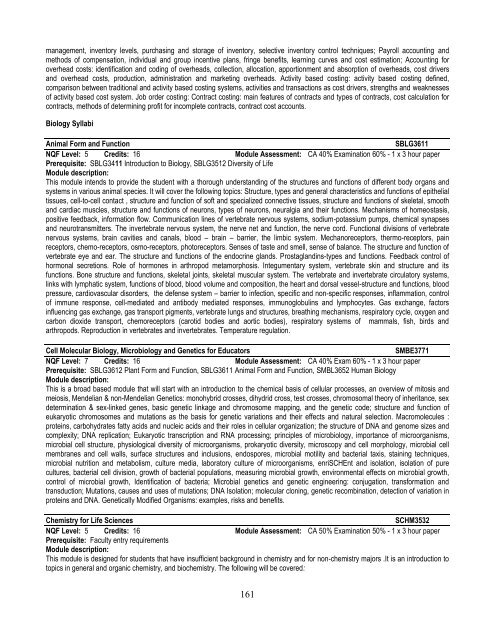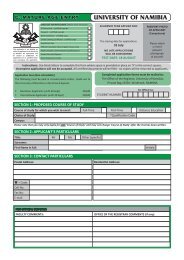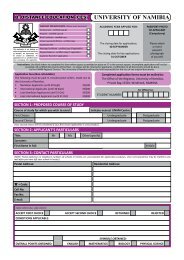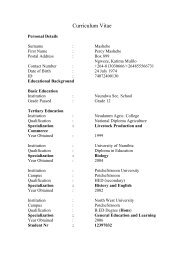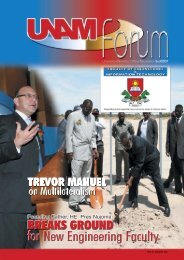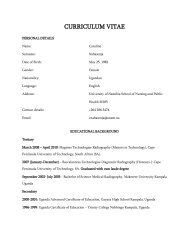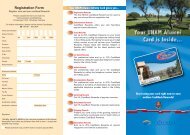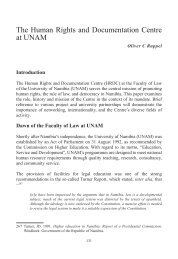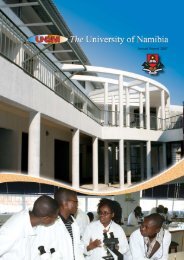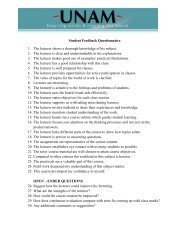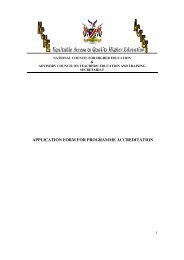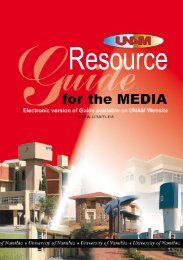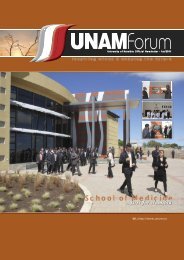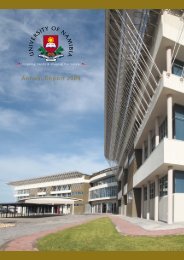UNIVERSITY OF NAMIBIA CENTRE FOR EXTERNAL STUDIES ...
UNIVERSITY OF NAMIBIA CENTRE FOR EXTERNAL STUDIES ...
UNIVERSITY OF NAMIBIA CENTRE FOR EXTERNAL STUDIES ...
You also want an ePaper? Increase the reach of your titles
YUMPU automatically turns print PDFs into web optimized ePapers that Google loves.
management, inventory levels, purchasing and storage of inventory, selective inventory control techniques; Payroll accounting andmethods of compensation, individual and group incentive plans, fringe benefits, learning curves and cost estimation; Accounting foroverhead costs: identification and coding of overheads, collection, allocation, apportionment and absorption of overheads, cost driversand overhead costs, production, administration and marketing overheads. Activity based costing: activity based costing defined,comparison between traditional and activity based costing systems, activities and transactions as cost drivers, strengths and weaknessesof activity based cost system. Job order costing: Contract costing: main features of contracts and types of contracts, cost calculation forcontracts, methods of determining profit for incomplete contracts, contract cost accounts.Biology SyllabiAnimal Form and FunctionSBLG3611NQF Level: 5 Credits: 16 Module Assessment: CA 40% Examination 60% - 1 x 3 hour paperPrerequisite: SBLG3411 Introduction to Biology, SBLG3512 Diversity of LifeModule description:This module intends to provide the student with a thorough understanding of the structures and functions of different body organs andsystems in various animal species. It will cover the following topics: Structure, types and general characteristics and functions of epithelialtissues, cell-to-cell contact , structure and function of soft and specialized connective tissues, structure and functions of skeletal, smoothand cardiac muscles, structure and functions of neurons, types of neurons, neuralgia and their functions. Mechanisms of homeostasis,positive feedback, information flow. Communication lines of vertebrate nervous systems, sodium-potassium pumps, chemical synapsesand neurotransmitters. The invertebrate nervous system, the nerve net and function, the nerve cord. Functional divisions of vertebratenervous systems, brain cavities and canals, blood – brain – barrier, the limbic system. Mechanoreceptors, thermo-receptors, painreceptors, chemo-receptors, osmo-receptors, photoreceptors. Senses of taste and smell, sense of balance. The structure and function ofvertebrate eye and ear. The structure and functions of the endocrine glands. Prostaglandins-types and functions. Feedback control ofhormonal secretions. Role of hormones in arthropod metamorphosis. Integumentary system, vertebrate skin and structure and itsfunctions. Bone structure and functions, skeletal joints, skeletal muscular system. The vertebrate and invertebrate circulatory systems,links with lymphatic system, functions of blood, blood volume and composition, the heart and dorsal vessel-structure and functions, bloodpressure, cardiovascular disorders, the defense system – barrier to infection, specific and non-specific responses, inflammation, controlof immune response, cell-mediated and antibody mediated responses, immunoglobulins and lymphocytes. Gas exchange, factorsinfluencing gas exchange, gas transport pigments, vertebrate lungs and structures, breathing mechanisms, respiratory cycle, oxygen andcarbon dioxide transport, chemoreceptors (carotid bodies and aortic bodies), respiratory systems of mammals, fish, birds andarthropods. Reproduction in vertebrates and invertebrates. Temperature regulation.Cell Molecular Biology, Microbiology and Genetics for EducatorsSMBE3771NQF Level: 7 Credits: 16 Module Assessment: CA 40% Exam 60% - 1 x 3 hour paperPrerequisite: SBLG3612 Plant Form and Function, SBLG3611 Animal Form and Function, SMBL3652 Human BiologyModule description:This is a broad based module that will start with an introduction to the chemical basis of cellular processes, an overview of mitosis andmeiosis, Mendelian & non-Mendelian Genetics: monohybrid crosses, dihydrid cross, test crosses, chromosomal theory of inheritance, sexdetermination & sex-linked genes, basic genetic linkage and chromosome mapping, and the genetic code; structure and function ofeukaryotic chromosomes and mutations as the basis for genetic variations and their effects and natural selection. Macromolecules :proteins, carbohydrates fatty acids and nucleic acids and their roles in cellular organization; the structure of DNA and genome sizes andcomplexity; DNA replication; Eukaryotic transcription and RNA processing; principles of microbiology, importance of microorganisms,microbial cell structure, physiological diversity of microorganisms, prokaryotic diversity, microscopy and cell morphology, microbial cellmembranes and cell walls, surface structures and inclusions, endospores, microbial motility and bacterial taxis, staining techniques,microbial nutrition and metabolism, culture media, laboratory culture of microorganisms, enriSCHEnt and isolation, isolation of purecultures, bacterial cell division, growth of bacterial populations, measuring microbial growth, environmental effects on microbial growth,control of microbial growth, Identification of bacteria; Microbial genetics and genetic engineering: conjugation, transformation andtransduction; Mutations, causes and uses of mutations; DNA Isolation; molecular cloning, genetic recombination, detection of variation inproteins and DNA. Genetically Modified Organisms: examples, risks and benefits.Chemistry for Life SciencesSCHM3532NQF Level: 5 Credits: 16 Module Assessment: CA 50% Examination 50% - 1 x 3 hour paperPrerequisite: Faculty entry requirementsModule description:This module is designed for students that have insufficient background in chemistry and for non-chemistry majors .It is an introduction totopics in general and organic chemistry, and biochemistry. The following will be covered:161


